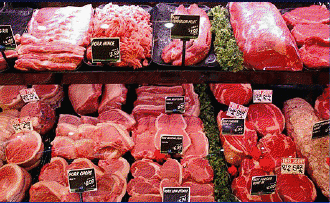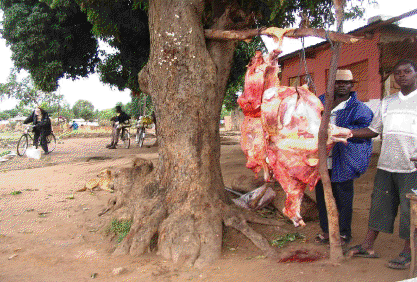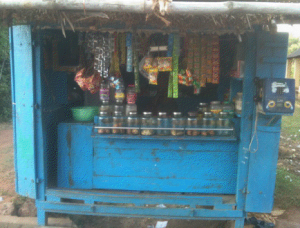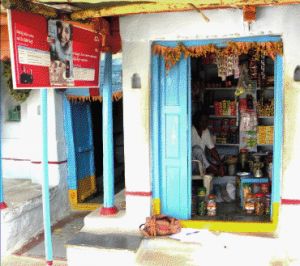Everybody in the world shops, but for some the experience is very different than for others. In Denver when I shop for a nice cut of meat to serve for company, the place where I shop looks something like this.
In rural Kenya, when a family is able to afford some meat for dinner, the place they shop looks more like this.

The Walmart or King Soopers or Whole Foods equivalent for the 2.6 billion people in the world who live on less than two dollars a day is the small mom-and-pop village shop which sells bananas, cigarettes, matches, cookies, candies, small packets of spices, cheap flashlights, chilled coke or Pepsi if electricity is available, and a variety of other consumable goods.
I’ve talked to a lot of these small shopkeepers and I find them fascinating.
A family usually starts out by buying some soap and bananas and offering them for sale out of their house by opening a shuttered window to the public.
This morphs into a small shuttered 10’x15’ shop, which earns bottom line income of two to four dollars a day, in which all the family participates. In total, there must be tens of millions of them-I don’t think anybody has counted.
The interesting thing is that commercial distribution to these small shops is still in its infancy. Shopkeepers I talked to in rural Orissa, in Eastern India, told me that they are visited by soda pop distributors- one distributor provides all the varieties available, including Coca cola, Pepsi, ThumsUp, Fanta, and locally produced small plastic sachets of drinking water. A typical shop sells 24 bottles of chilled pop a day during hot weather at 10 rupees a bottle (about 22 cents) on which the shopkeeper earns a margin of 1 Rupee (2.2 cents). Another distributor brings candies and cookies. All told, commercial distributors bring only about a third of the products that each shopkeeper sells. The shopkeeper barters with customers for products like bananas or rice and goes to the wholesale market in the nearest town to buy the rest of what he puts on the shelf.
All told, commercial distributors bring only about a third of the products that each shopkeeper sells. The shopkeeper barters with customers for products like bananas or rice and goes to the wholesale market in the nearest town to buy the rest of what he puts on the shelf.
Think what could happen if a Tata or a Walmart would do a serious study of the current shelf space of these mom and pop stores.
They could create a whole new line of attractive affordable consumer goods delivered by an efficient last mile supply chain. This would bring new prosperity to rural villages, remarkable public relations with a whole new generation of customers and attractive bottom line profits to the company with the courage to give it a try!



Pingback: Tweets that mention Shopping | Paul Polak | Out of Poverty -- Topsy.com
Hi Paul,
Let’s see if you dream can come true.
We are going to release the Campaign for Global Humanitarian Relief (GHR) very soon which can support your dream!
YouTube: http://www.youtube.com/user/abc4allteam
Home: Global Humanitarian Relief Day (GHRD) #97 in the ABC4All COUNTUP! GHRD is EVERYDAY!
http://abc4allghrd.abc4all.net
JOIN GHRD and then benefit from GHR Rewards4All!
http://ghrd.abc4all.net/join/request/
if you need password, use joinghrdp
Will be in Denver, 1st week in Sept.
Can I come visit your organization?
Blessings.
Richard Dassow
I’ve been wanting to create (and see others produce) graphics/photo compilations that juxtapose the extremes such as this White House + lack of sanitary water graphic http://www.endwaterpoverty.org/news__events/212.asp
Getting more juxtaposed compilations into circulation can stimulate more surprise and click into people’s brains some kind of response that something should have been done about this and needs strategic action *now*.
Related to shopping, I’ve created a virtual store list for “the other 90%” intended as a stimulant towards thinking more about a “micro-giving” platform that would connect rich to poor to fulfill global need requests. I’ve posted it at http://www.phibetaiota.net/?p=26742
I’ve also recently posted about the Art of Dirt event http://www.phibetaiota.net/?p=27609 and the International Development Design Summit at Colorado State Univ http://www.phibetaiota.net/?p=26720
Hi Paul: An excellent post.
My company Haddock Invention will endeavor to be the Tortoise to your Hare — we’re going to race Windhorse in getting cleantech into this global network of small shops.
Our ticket in is the disposable battery, an energy carrier that is several hundred times more expensive than solar power on a cost per energy basis — an astounding 5B+ USD market inefficiency which we aim to fill with solar recharged AA/C/D rentable batteries, at the individual small shop level. Just like folks buy scratch-off cards for cell phone minutes, folks will buy charges on a rechargeable NiMH AA/C/D standard-sized battery — my company owns and maintains the solar chargers, the stores own the batteries, and the customer owns nothing — other than the energy in the batteries.
The idea crystallized at this year’s IDDS just a few months ago, and we are jumping directly into a pilot with three shops in Guatemala in a few weeks. If the pilot shows any promise, we hope to get the systems in 1000 shops in under 1000 days.
Customers will save 30-50% on their small battery costs, the shops will pay back their battery buy-in in 1-2 months (and make double the margins they made on the throw-away batteries), and my company and distribution partners get a good piece of the battery rental action as well. All possible because the cost of energy in a one-time use battery is so tremendously higher than energy from the sun, stored in a recharged AA/C/D battery.
If you hit 1000 shops before we do, I will eat my shoe.
Best of luck even so. I really enjoy catching your blogging now and again. Thanks for leading the way.